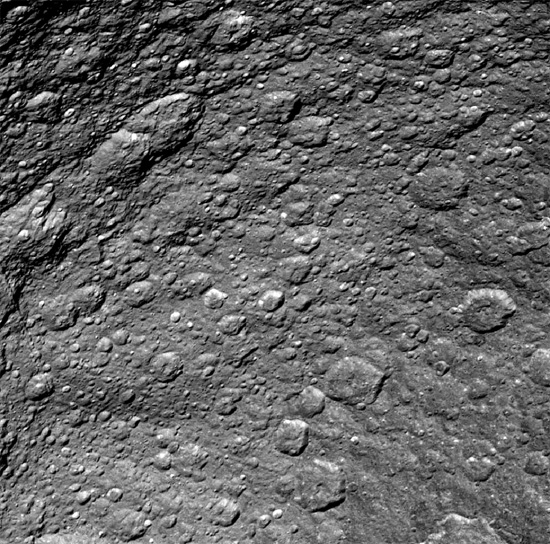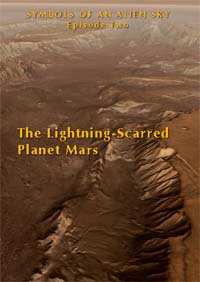|

The crater-strewn surface of Rhea.
Credit: NASA/JPL/Space Science
Institute
Daughter of Earth and Sky
Jan
14, 2010
Saturn's moons are difficult
to explain without including an
Electric Universe hypothesis.
Rhea is one of Saturn's
moons that bears examination in
light of electrical theories. Even
though Rhea's mean diameter is only
1528 kilometers, its entire visible
surface is
pocked with craters. One
large
basin is
360 kilometers across and six
kilometers deep, giving it the
distinction of being the most
cataclysmic event in the moon's
history. Anything larger would have
blown it to bits.
Recent images from the
Cassini-Equinox spacecraft reveal a
moon that has been bombarded by
powerful forces. Consensus science
sees asteroids and meteors as the
common cause. The Electric Universe
offers alternatives to those
commonly accepted beliefs.
A
bright splotch on Rhea
covers almost an entire hemisphere.
Since it resembles the
rayed structures
on Earth's Moon, planetary
scientists attribute its formation
to an asteroid impact explosively
throwing debris outward in radial "ejecta
blankets" millions, if not billions
of years ago. However, previous
Thunderbolts Picture of the Day
articles have noted that those
formations are more likely the
result of electric arcs and could be
due to relatively recent events.
The rays surrounding the large
central crater are not
deep but look more like a thin layer
of dust without the gradual sizing
of the granules as they recede from
the point of influence. They were
probably deposited by an "electric
wind" as the plasma arc reduced the
surface rocks to fine powder.
Another strange feature of Rhea
is the large concentration of
hexagonal craters,
although nearly every
rocky body in the Solar
System,
Earth included, exhibits
similar structures. How can a
colliding rock cause a hexagonal
crater? No experiment can create a
polygonal shape after an explosive
event. No, as pointed-out in several
previous Picture of the Day
articles, hexagons are created when
intense particle beams touch down on
a solid surface.
Electric arcs are composed of
Birkeland current filaments.
Researchers studying the issue have
found that beams of electricity
flowing through plasma create a
central column surrounded by
concentric cylinders. The
cylindrical discharge can sometimes
form
diocotron instabilities
in the vortex, forcing a hexagonal
shape. As the filaments rotate
around one another, a hexagonal
cross-section forms within the
innermost column.
Cassini's January 11, 2011 flyby
found that almost all of
Rhea's craters occur in
multiples, the majority of the
larger ones are in pairs with many
smaller craters
distributed around them
non-randomly. Many of them are found
on the rims of the large craters.
In so-called "spark machining"
equipment electric discharges
"stick" to one spot for a split
second, cutting microscopic craters
as the main discharge rotates within
a larger one. The typical shallow,
flat floors of the craters, together
with central bumps, provide a
perfect match with the patterns
created by plasma physicist C. J.
Ransom in his
laboratory arcing
experiments.
These are only a few examples
that indicate Rhea's features did
not undergo a slow condensation out
of a nebular cloud. Rather, electric
arcs probably tore its surface. What
has been left behind is a forensic
record of past conditions in the
form of fractures, chaotic terrain,
and
gigantic caldera as big
as the state of Wisconsin.
Rhea might once have been caught
in the grip of an interplanetary
particle beam that excavated its
craters. Due to plasma instabilities
in the discharge, hexagonal
formations remain, “fossilized”
geometric shapes permanently burned
in.
Stephen Smith
Multimedia

The Lightning-Scarred Planet Mars
Symbols of an Alien Sky
DVD episode 2
A video documentary that could change everything you thought you knew
about ancient times and symbols.
The Symbols of an Alien Sky video series will introduce you to celestial
spectacles and earth-shaking events once remembered around the world.
Archaic symbols of these events still surround us, some as icons of the
world’s great religions, though the origins of the symbols appear to be
lost in
obscurity.
In this second episode of Symbols of an Alien Sky, David
Talbott takes the viewer on an odyssey across the surface of Mars.
Exploring feature after feature of the planet, he finds that only
electric arcs could produce the observed patterns. The high resolution
images reveal massive channels and gouges, great mounds, and crater
chains, none finding an explanation in traditional geology, but all
matching the scars from electric discharge experiments in the
laboratory.
(Approximately 85 minutes) See:
Lightning-Scarred
Planet info
|








